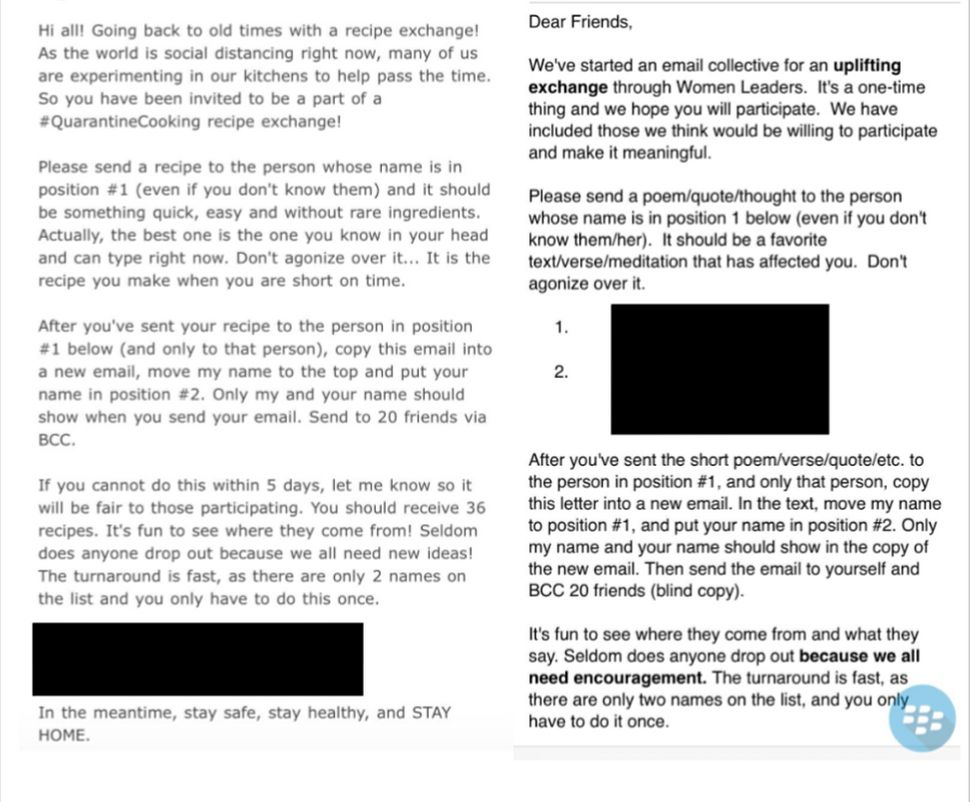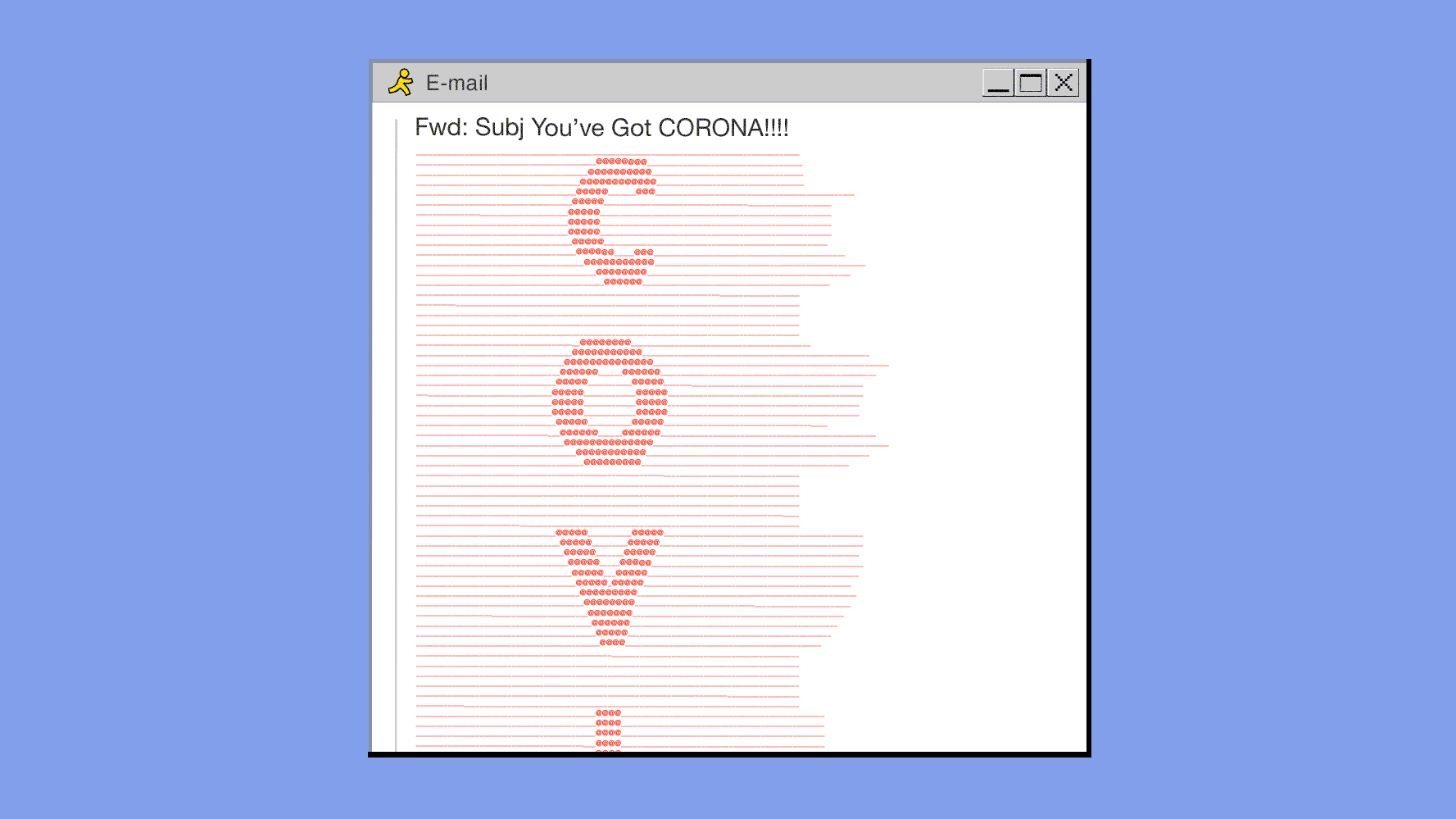[ad_1]
I have a confession. In April, I participated in a chain email.
Going back to old times with a recipe exchange! As the world is social distancing right now, many of us are experimenting in our kitchens to help pass the time. So you have been invited to be a part of a #QuarantineCooking recipe exchange! Yay!
I sent along my grandmother’s recipe for ginger carrot soup to the first name on the chain and then proceeded to forward it to 20 friends, moving the sender’s name up to the first slot and putting my own in the second. Within a few days, I had received a handful of lovely recipes. And within a week, I had been sent virtually the same chain email by a handful of friends spread out across the country.
The next week, I got a few more chain emails, this time asking me, as a “woman leader,” to send a thought or quote or verse or poem to one woman and then pass the message along to other “women leaders” in my network. This one I didn’t pass along. The number of emails had started to stress me out. (Sorry, Mom.)
The truth is that if 2020 were progressing normally, I probably wouldn’t have even opened the original recipe exchange email, instead allowing the thing to flounder in my inbox unread until I forgot about it and stopped feeling guilty for not passing it on. But in New York City, we’ve been in quarantine for nearly eight weeks, and overnight, my world contracted intensely. My daily rituals were stripped away, leaving me mostly alone and sometimes with my boyfriend. So when a colleague sent along that sweet little recipe exchange, I figured, hey, a girl’s gotta eat (three meals a day in her 450-square-foot apartment), and she only knows how to cook so many things.
Lots of people have found themselves on the receiving end of the same handful of chain emails, as well as chain-like posts on Facebook, Instagram and Twitter. And not only have many people received this chain mail, but they have also responded to it, maybe even passing it along.
“In pre-COVID times, I would have been so judgy of this,” said Brigid Warnke, 28, of the email she received in April soliciting inspirational quotes from women leaders, “but now, all bets are off!”
I heard from nearly a dozen women, all between the ages of 25 and 45, who had received and interacted in some way with digital chain mail over the last month. Some were surprised to report that they felt nostalgia and increased connection as a result of these exercises. Others felt stressed out, or simply annoyed.
But they all wondered why it felt like these digital chains seemed to be increasing, and why they felt oddly compelled to participate in the chain.
Pass This Along To 5 Friends
These digital chain letters come in different packages, passed along on different platforms, but they all have the same basic goal: Getting people to perform low-lift, innocuous tasks and then urge their networks to do the same.
There are the email varieties, like the recipe exchange I participated in, and the women leaders exchange I skipped over. Then there are the social media posts, asking for the recipient to fill out random fun facts about where they’d like to travel if they could or their perfect post-quarantine day. And, of course, tag five friends at the end to do the same.
Prathi Yeddanapudi, 41, and Nicole Carter, 25, both said that they had gotten a chain email asking them to pass along one-time “words of encouragement” or “good wishes.” For Carter, who is in graduate school in Baltimore, the email came by way of a classmate, and because her program is a close network, she then got the same email about six times from different people.
“I thought it was a nice sentiment, but I did plenty of those back in middle school,” Carter said. “They don’t need to come back in my adult life!”

For Gwyneth Davies, 26, the impulse to pass along an easy recipe and then forward the email to seven, not 20, of her friends, felt somewhat practical. However, she texted them all ahead of time to apologize, “because, LOL chain emails.”
“I chose to participate for two reasons,” Davies said. “I legitimately was in need of inspiration for cooking since I’ve been eating the same chicken and rice dish every week, and the second is the desire for connection to a larger body of people that isn’t Facebook or Twitter.” The recipe exchange accomplished both things, albeit in a small way.
Sandra Di, based in New York City, told me that she had found herself sucked in by chain Facebook posts for reasons she doesn’t really understand. “People keep posting ‘25 questions about me’ on Facebook,” she said, “and for some reason I keep responding with these ridiculous ‘fun facts.’”

Erica Robles-Anderson, an associate professor of media, culture and communication at New York University, confirmed that the uptick in digital chain mail was a real thing, not merely a figment of my quarantine brain. As an academic, she had also been touched by the chain mail trend, repeatedly being tagged in Twitter posts asking her to tweet her favorite poem at five people and pass the message along.
“You see [chain emails being passed around] in [groups of] older people, you see it even amongst very established academics,” Robles-Anderson said. “People who you would think, there’s no way that they need this.”
She also noted that participants in these digital chains spread across “various class positions and professionals, statuses and age groups” in a way that she deemed “striking.”
The Origins Of Chain Mail
Turns out that there is a long history of chain letters coming into vogue during periods of social and economic uncertainty. That chain email you got in the early aughts telling you that if you didn’t pass it along you would be cursed forever and never fall in love originated from real paper mail.
“You see the basic structure [of the chain letter] pop up over and over again in these kinds of moments of economic downturn,” Robles-Anderson said, noting that the Great Depression was a real heyday for scammy pyramid-scheme-like chain mail.
One of the earliest documented chain letters was not scammy but was absolutely economically motivated. In 1888, a Methodist academy for female missionaries in Chicago found itself in dire financial straits, saddled with debts and in need of $16,000. So the women decided to try something new. Instead of just soliciting funds from their usual sources, they sent out letters asking each recipient to contribute one dime, then make three copies of the letter and pass it along to three friends. One of the academy’s founders later wrote that she had sent out about 1,500 original letters “from the Message List and to my personal friends, trying to avoid people who I knew to be specially busy.” Then, a chain was born.
The Chicago Training School received more than $6,000 in donations. Many of the letters sent back contained “a much larger sum than that asked for — one, two hundred times the dime.” These “Dime Letters” became proof of concept. Ask — and ask and ask and ask — some friends, and ye shall receive.
You see the basic structure [of the chain letter] pop up over and over again in these kinds of moments of economic downturn.
Erica Robles-Anderson, associate professor of media, culture and communication at NYU
During the Great Depression, desperate, financially strapped Americans returned to these “dime letters,” but with more of a Ponzi scheme twist. Starting in Denver and dubbed the “Send-a-Dime effort,” letter receivers were encouraged to send money to the first names on the list they received, and then copy the letter and send it along, moving names up and adding their own name to the bottom. But given the finite number of people that could be roped into the scheme, names high up on these lists got their money back plus a lot extra, while others simply sent out money and never got a return.
These chain letters became so popular that chain letter brokerages popped up across the country, essentially selling stock certificates for high-value chain letter names. Eventually, the scheme imploded and Western Union was sued for $27 million for its role in perpetuating the fraud.
Like any structured communication facilitated by expanding networks, chain letters can easily go from benign to exploitative during moments where people feel desperate, both socially and economically. Over the following decades, schemes similar to the Send-a-Dime effort popped up sporadically, like the “Circle Of Gold” ploy in the late ’70s in which letters could be purchased, with half of the money going to the seller and half to a name on the list. Each person who acquired a letter was then tasked with selling two more —not dissimilar to the structure of modern multilevel marketing companies.
When it became more mainstream to own personal computers and have access to the internet during the ’90s, physical chain letters died out, replaced instead by email. The ease with which emails can be passed along both lowered the stakes for these letters and changed the rules of what constituted chain mail. (Some threatened to kill your crush if you didn’t pass it along, others simply asked for a list of mundane facts about yourself.) They became less clearly tied to economics — perhaps in part because the U.S. economy was generally doing well — but they still held on to the same basic idea: establishing ever-expanding networks.
When The Chain Connects Us
It is that desire to expand and test our social networks that connects the digital chain mail of 2020 with those pleas for dimes in Chicago in 1888.
Robles-Anderson sees chain mail as a way for us to subconsciously check that our channels of communication are functioning during moments when we are fearful and unsteady.
“Just in case I had something meaningful to communicate in a crisis, I would want to know that the phone line was working,” Robles-Anderson said. “And so, [chain mail] is like background chatter noise to make sure that the social world is still functioning. It’s like pinging each other in some little way.”
Receiving a recipe from a stranger actually gave me a feeling of reassurance, almost like reaching out to strangers was a humane acknowledgment of what we’re collectively experiencing.
Gwyneth Davies, 26
This is why we see digital chains circulating across every available platform and see them really take off during periods of economic downturn. A pandemic in which some of us cannot physically be with our families or colleagues or friends surely qualifies as a moment of crisis where we might be grasping for confirmation that those networks still exist, even if we can’t see them.
Asked why she had participated in a recipe exchange chain email, Davies didn’t hesitate: “We’re all lonely!” she said. “Receiving a recipe from a stranger actually gave me a feeling of reassurance, almost like reaching out to strangers was a humane acknowledgment of what we’re collectively experiencing, and that we are trying to look out for the physical and emotional needs of even the neighbors we don’t know.”
The emails may be about poetry and leadership and recipes and travel plans, but what they really are getting at is something much deeper than that: our basic human desire to connect with each other, to create networks, to feel safe and protected and looked out for.
“I think we aren’t really prepared, in fact, to deep dive into a conversation about how our life is going,” Robles-Anderson said. “[Digital chain mail is] like a little tiny tendril of something that seems low-risk and confirms that there is a social web of connection. And it’s not a broadcast — it’s just a tiny little confirmation.”
Laura Burch, 41, simply found comfort in the idea that she might brighten a stranger’s day by passing along an Emily Dickinson poem and a Miley Cyrus video. She did, in fact, hear back from the woman she had emailed — someone she had never met who lives in London.
“Hearing from that stranger who reached out from halfway around the world to tell me she liked what I sent her made me feel like I had made a small impact,” she said. “I think we’re all looking for something good right now. We just want to feel comforted.”
Calling all HuffPost superfans!
Sign up for membership to become a founding member and help shape HuffPost’s next chapter
[ad_2]
Source link

